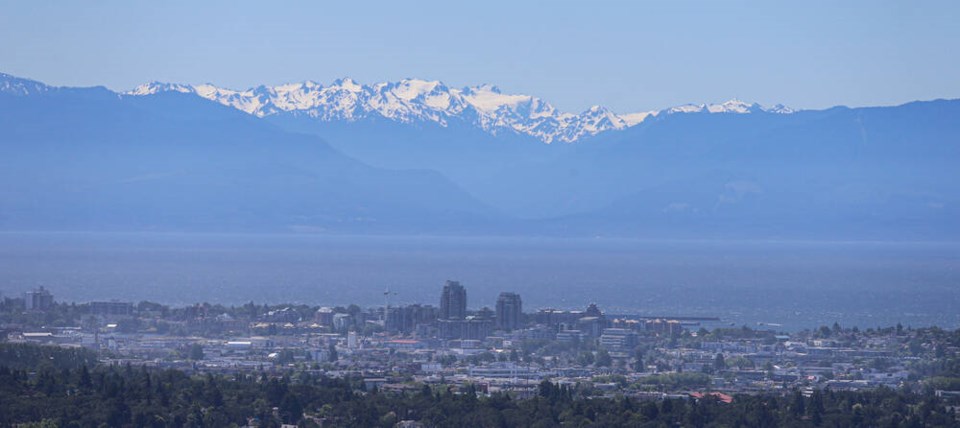A couple of weeks ago, a reader wrote in with a puzzler.
For decades her mailing address was written as Victoria, even though she lives in Esquimalt. Then one day, when looking up her own postal code, she discovered her address is now, at least officially, Esquimalt, B.C.
So she checked to see whether this applied to other core municipalities, too. Nope. Canada Post lumps Saanich and Oak Bay in with the capital. Ditto for Langford, Colwood, View Royal and Metchosin. As far as the post office is considered, they’re all Victoria. Curiously, though, Sidney is Sidney and Saanichton, which isn’t even a stand-alone municipality (yet), has its own designation.
Well, explains Canada Post, usually your mailing address corresponds to the city in which your letters are sorted. That’s the way it is unless a local government requests a change, which is what the Township of Esquimalt did several years ago.
Surprising? Not really. Esquitians (my term, and, alas, one that has failed to gain traction) have a keen sense of identity and pride in their community. That makes Esquimalt like Quebec, periodically pondering the question of whether it’s preferable to exist as a distinct society within a greater whole, or to exist as its own sovereign entity.
Which is what came to mind this past week when Esquimalt council once again declared its intention to break free of its two-decade-old shotgun marriage with VicPD.
Esquimalt’s frustration is well documented and understandable. It alone, among Greater Victoria’s dozen joined-at-the-hip-but-not-the-head municipalities, helps the City of Victoria shoulder the disproportionate cost of policing the region’s downtown, which, like downtowns everywhere, is where people from throughout the area flock to work, play, drink too much, buy drugs, protest and punch each other in the mouth.
Ultimately this all comes back to the same root issue — not how Greater Victoria is policed, but how it is governed, overseen by a patchwork of councils, each with its own agenda and suite of services. No other Canadian community of this size is divided this way.
It can make for awkward administrative gymnastics. In 2016, Jim Anderson of Amalgamation Yes documented 365 agreements covering how various groupings of the capital region’s local governments work together on everything from stormwater runoff and cemeteries to the emergency radio system.
Deals are cobbled together by some jurisdictions for particular purposes (yard waste dropoff for residents of Esquimalt and View Royal, for example), yet in areas where you might think co-ordination would be a priority, it is absent. Some municipalities share recreation facilities, but those in the core do not. If you wonder why we lack arts venues on par with those of similar cities, note that only Victoria, Saanich and Oak Bay contribute to the CRD-owned Royal Theatre, while Victoria alone pays for the McPherson Playhouse.
Budget quirks abound. Victoria complains about the cost of policing, but isn’t exactly volunteering to share the big whack of property taxes it gets from all those downtown businesses (or, for that matter, the $17 million it collects in parking fees and fines).
Esquimalt has very little commercial property to tax, but does enjoy an annual payment for CFB Esquimalt — $12.7 million this year — that amounts to one-third of its entire revenue (despite the fact that the base has its own military police, fire department, recreation facilities).
View Royal gets close to a couple of million a year for being home to the casino, with a similar amount split among Langford, Colwood, Esquimalt, Metchosin, Sooke and Highlands. Residents of the five West Shore municipalities share a single RCMP detachment, but pay for it at different rates due to federal subsidies based on population. And so on.
Ah, but any time someone has the temerity to suggest that maybe, just maybe, we should look at the benefits and drawbacks of reducing the number of municipalities, some politicians react as though they had been charged with defending Camelot, not one of our many, many Saaniches, or whatever.
Never mind that the people of the region themselves are generally receptive to looking at change.
In 2014, when voters in eight local municipalities were presented with some form of amalgamation question, only those in Oak Bay said no. In Esquimalt, two-thirds of voters said yes when asked if they favoured an amalgamation study, indicating that pride in community doesn’t necessarily go hand in hand with political independence.
In 2018, voters in Saanich and Victoria approved funding for a citizens assembly that would look at the costs, benefits and disadvantages of marrying the two communities, yet it wasn’t until this March that the two municipalities and the province finally announced an agreement to move the process forward — though even then they said it woudn’t happen until after October’s local elections.
Meanwhile, we poke along with a system that drives us to seriously consider adding yet another stand-alone police department for a community of 17,500 within a city of 400,000.



